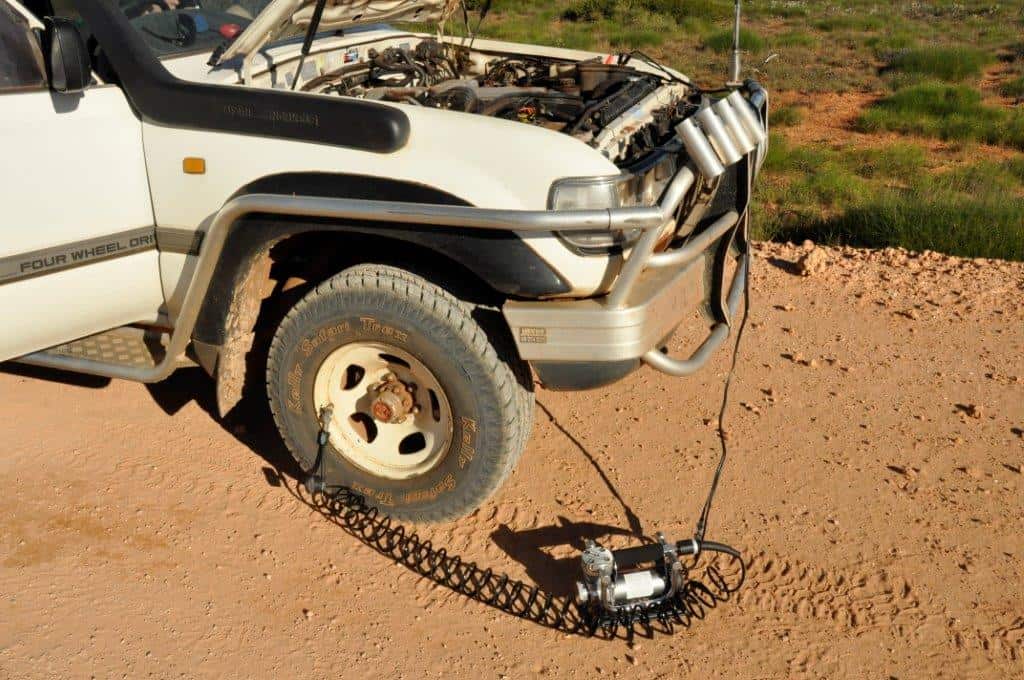What is the must have 4WD recovery gear?
There’s nothing worse than coming across a someone bogged to the chassis in their 4WD, with zero recovery gear on board. It’s embarrassing for them, and you have to supply the recovery gear.
Before you take your 4WD off the bitumen, there are a number of things that you must have with you. Most people refer to it as a 4WD recovery kit. In this post, we answer ‘what recovery gear do I need’.
If you are going with a group of people and can share the gear you don’t need any of the below (as long as your mates have them!), except for the rated recovery points. Take a minute to read this too – 20 things you should never do in a 4WD recovery.

Tyre gauge
Tyre pressures are the most important thing you can control when it comes to taking your 4WD off road. The main reason people get bogged in the first place is due to incorrect tyre pressures. The moment you leave the bitumen, you should be letting air out of your tyres.
Every terrain requires different tyre pressures (beach driving/mud driving/rock driving, gravel driving etc) and the only way to accurately deflate your tyres is with a gauge. You can get a tyre deflator, but if you are on a budget you can easily deflate your tyres with your key, a rock or a stick!
For starters, have a read of this post; 6 reasons tyre pressures are critical when 4WDing.

Shovel
Even though using a shovel may not be the activity you look forward to the most, a few minutes on the end of a shovel can save you a whole lot of time and effort later on. When I say shovel though, I don’t mean one of the 50cm shovels that fold up and get buried underneath everything in the back of your car.
These are not very suitable for recovering a 4WD. Ideally, you want a full length shovel so you can dig safely under the chassis of your vehicle. There’s some pretty nifty ones on the market that screw together, so they pack away nice and compact.

Rated Recovery Points
Recovery points are something a lot of people forget about, and by the time they have a chance to think about them they are bogged in the middle of a giant mud puddle. You need to have Rated recovery points, not tie downs, and you need to know where they are.
I say as a minimum you need one rated recovery point on the front, and the rear, so you can be recovered from either direction. These are not very expensive, but are an absolute necessity for safe recoveries. If you have a recovery hitch on the rear, you can recover off the pin. Just don’t do it off a tow ball!

Snatch Strap
These days, the Snatch strap is often the go to bit of gear when someone gets hurt. They are a fantastic idea and they work extremely well. However, use them with caution; they are also incredibly dangerous and have killed people in the past. When should you use a Snatch Strap?
The best 4WD recovery kit will also be suitable for your weight vehicle; don’t get under, or oversized snatch straps in particular!

Tyre compressor (12V)
Once you’ve finished 4WDing, you need a way of pumping your tyres back up. Driving with deflated tyres on bitumen will cause your tyres to heat up, and will do permanent damage to them if you aren’t careful. That, and it’s not very safe to drive with low pressures at higher speeds. Compressors are easily shared between mates, but be prepared to wait a bit longer at the end of your 4WDing adventure.

Rated bow shackles
It’s a good idea to carry two 4.75 tonne rated bow shackles. These should not be used if it can be avoided, but a lot of recovery points require a shackle to attach the strap or winch to them. There is nothing wrong with using shackles, but its a good idea to reduce any potential missiles, should something break.
If you have hooks, use them over a shackle. If you need to join two straps, join them correctly, without a shackle.

An understanding of tyre pressures and 4WDing
This is not exactly gear, but taking your family out for a day at the beach in your 4WD with no idea of how to engage low range or why you let your tyres down is a recipe for disaster. The best way to overcome this is to go with a competent mate, and learn on the job.
Make sure you know how to lock the hubs, put the vehicle in 4WD, what tyre pressures you should be running for the given terrain, what to do if you start to sink down, what tracks to take and how you need to prepare your vehicle. For the ultimate guide, check this out – 42 things you must know about 4WDing.
Have you got all of the above?
Considering the average price of a 4WD, the above gear is not that expensive. You really need to get it before you head bush, or you could end up in a sticky situation. What do you have in the way of recovery gear in your 4WD?







Hey Mark,
Honestly, I’ve been out of the compressor game for a while. Our Bushranger Super max is still going strong. There are lots of options out there. I can’t vouch for any of them as I haven’t had much hands on experience with others. As for tyre plug repair kits, ARB sell a good one, as do most of the other major 4WD companies. Mines just a yellow box from Repco which has everything we need
All the best
Aaron
Can you recommend a good tyre compresser and tyre puncture repair plugs kit